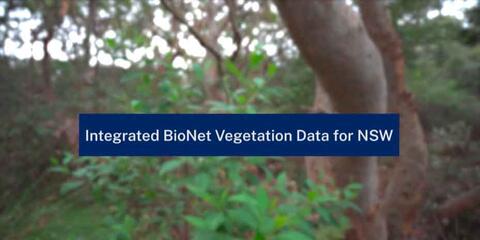The Integrated BioNet Vegetation Data (IBVD) program modernises how we work with vegetation classification and map data by providing a suite of related foundational information products based on a single classification framework and map for the state.
Watch the video: Introduction to Integrated BioNet Vegetation Data for New South Wales.
Vegetation classification data and maps are combined to provide a single resource stored in BioNet and discoverable on the SEED (Sharing and Enabling Environmental Data) portal.
We have designed the Integrated BioNet Vegetation Data program to support users undertaking land management activities and biodiversity assessments.
BioNet allows vegetation classification and map data to link to other biodiversity information commonly applied in biodiversity assessments, including threatened ecological communities and threatened species data.
Integrated BioNet Vegetation Data is an important ongoing program to develop and maintain publicly available high-quality native vegetation classification and map products for New South Wales.
Latest news
- The second update of Integrated BioNet Vegetation Data was released in November 2024. No changes were made to the plant community type (PCT) master list, with version C2.0 remaining current. Updates were made to the State Vegetation Type Map (SVTM) to version C2.0M2.1. Three plant community types had threatened ecological community (TEC) associations added in response to either user feedback or new TEC listings. The 2024 release is part of the ongoing effort to continuously improve the State Vegetation Type Map and the NSW plant community type classification and associated information.
- The new Restore Trees NSW app also delivers information from the State Vegetation Type Map.
What data are included in the Integrated BioNet Vegetation Data program?
NSW vegetation classification hierarchy
Plant community type descriptions and data are maintained in the BioNet Vegetation Classification application.
This includes the vegetation class and vegetation formation, in which each plant community type is nested.
For more information about the plant community type classification program, visit the NSW plant community type classification webpage.
A summary list of plant community types is available by clicking download on the BioNet Plant Community Type Data page.
State Vegetation Type Map
The State Vegetation Type Map covers individual plant community types, vegetation classes and vegetation formations.
For more information about the map, visit the State Vegetation Type Map webpage.
Access the map directly from the SEED (Sharing and Enabling Environmental Data) portal or Trees Near Me NSW.
BioNet flora survey plots
Standard floristic survey plots are maintained in the Flora survey module of the BioNet Atlas application.
Plots used in defining plant community types in eastern New South Wales provide reference points for plant community types.
View plant community type reference plots on the SEED (Sharing and Enabling Environmental Data) portal.
Threatened species and threatened ecological community plant community type associations
New South Wales and nationally listed threatened species, populations and threatened ecological communities are expertly associated with plant community types, vegetation classes, and vegetation formations. This indicates potential threatened species habitat or the potential presence of a threatened ecological community.
Threatened species, threatened populations and threatened ecological community plant community type associations can be downloaded.
Vegetation condition benchmarks
Vegetation condition benchmarks provide a framework for measuring the integrity of vegetation used in the Biodiversity Assessment Method.
Vegetation condition benchmark data are maintained in the BioNet Vegetation Classification application.
What tools and applications are linked to Integrated BioNet Vegetation Data?
SEED (Sharing and Enabling Environmental Data) portal
Trees Near Me NSW application
The Trees Near Me NSW app – winner of Gold in the GOV Design Awards 2023.
Trees Near Me NSW delivers map and plant community type information in an easy-to-use mobile app and website. It allows users to find information on plant community types within 200 metres, 400 metres and 1,000 metres of any location in New South Wales.
Restore Trees NSW application
Restore Trees NSW delivers environmental information including the State Vegetation Type Map as well as a host of information about seed supply, funding opportunities, citizen science and connecting with Country. It is a great tool to support land managers and community groups plan their restoration projects.
Plot to PCT Assignment Tool
The Plot to PCT Assignment Tool is a plant community type identification tool for eastern New South Wales. It allows users to upload standard floristic survey plots to obtain a robust comparison to the quantitative plant community type classification. It provides detailed downloadable information about each matched plant community type.
